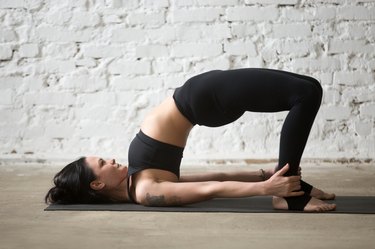
Injuries to your thigh and hip muscles can affect not only how you exercise, but also simple activities like walking, bending down and overall movement. Tensor fasciae latae exercises can help properly heal and strengthen a strained or damaged leg muscle.
Read more: 3 Simple Stretches to Help Relieve Hip Pain
Video of the Day
Video of the Day
Tensor Fasciae Latae Exercises
The tensor fasciae latae is a relatively small muscle at the top outside edge of your hip. Its insertion point is at the head of the large iliotibial band that runs down along the outside of your thigh. The function of the tensor fasciae latae muscle (sometimes called tfl) is to help offer support for the iliotibial band, which in turn stabilizes the hip and knee joints. This small muscle also allows you to flex, abduct and internally rotate your hip.
If you're looking for exercises for tfl pain, these movements can help damaged muscles, loosen tight hip flexors and increase flexibility, according to a 2019 review from the International Sports Sciences Association (ISSA), but check with your health care provider to be sure these exercises are safe for you to do:
Move 1: Single-Leg Squat
- Stand with your feet together.
- Lift one leg up and point it forward while pushing your weight into your grounded leg.
- Keep your chest and head looking at a spot on the wall to keep them from looking down.
- Move the hips and butt back, like you're sitting down into a chair.
- Don't move your knees over your toes.
- Lower yourself down and stand back up straight.
- Switch legs.
- Do 5 reps on each side.
Move 2: Glute Bridge
- Lie on the floor on your back.
- Bend your knees and keep your feet flat.
- Lift your hips as high as possible until you can feel your glutes contract.
- Squeeze your glutes together.
- Slowly lower your hips back down to the ground.
- Do 10 reps.
Move 3: Mountain Climbers
- Lie face down on the floor.
- Push yourself up into plank position by extending your arms straight and distributing your weight evenly between hands and toes.
- Make sure your arms are shoulder-width apart and your head is properly aligned.
- Flatten your back and engage your abs.
- Pull your right knee into your chest as far as possible.
- Move your right leg back into the plank position.
- Move your left knee into your chest as far as possible.
- Start to move faster.
- Do 20 reps (10 reps on each side).
Read more: 7 IT Band Stretches Every Runner Should Do
Prevention and Treatment
To prevent future damage to the tensor fasciae latae, you should always warm up before any cardio workout or when weightlifting with your legs. This can help increase blood flow to muscles and joints, making them less apt to workout injury, according to a December 2018 review from Harvard Health Publishing.
You should also ease into any cardio workout. Whether you're a beginner or advanced, you shouldn't push too hard after rehabbing your leg muscles. If you feel lightheaded and tingling limbs or you're feeling dizzy with tingling arms, you should stop exercising immediately.
For additional tips to avoiding injuries, Harvard Health Publishing says to do the following:
- Listen to your body. Cut back if you can't finish a session.
- Replace shoes every six months as they wear out.
- Lift lighter weights and do fewer reps and sets when you resume your weightlifting routine.